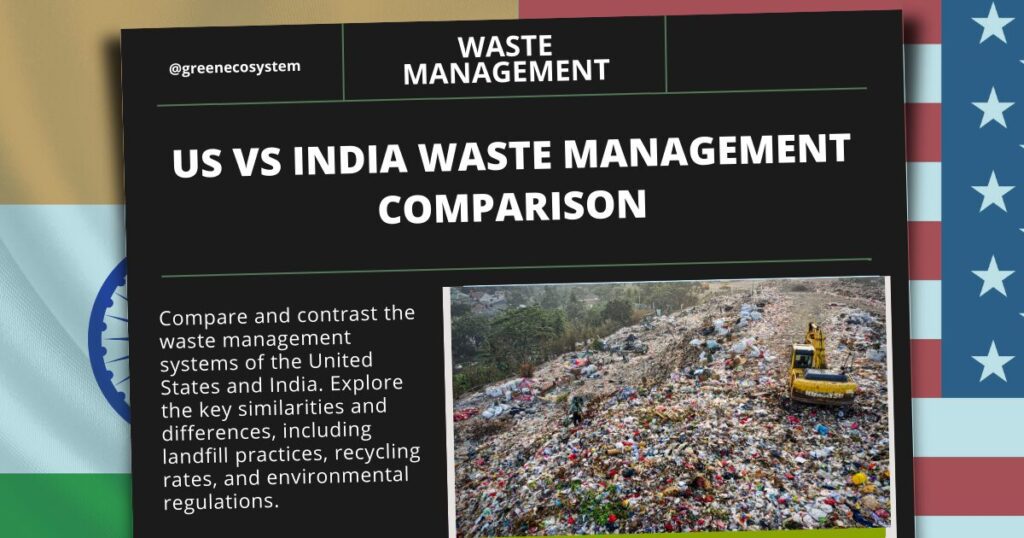The global waste crisis is a pressing environmental challenge, and countries around the world are grappling with how to manage their waste effectively. The United States and India, two of the world’s largest and most populous nations, offer a fascinating case study in contrasting approaches to waste management systems. Despite their shared status as major economic powers, these countries have adopted vastly different strategies for dealing with their waste. In this blog post, we will explore the key similarities and differences between the US vs India waste management comparison, and consider the implications for the environment and public health.
Waste Management System in the United States
The United States has a long history of waste management practices, dating back to the early days of industrialization. Today, the country’s waste management system is characterized by a mix of public and private sector involvement, with a strong emphasis on recycling and waste reduction.
Key features of US waste management:
- Landfills: Landfills remain the primary method of waste disposal in the US, although there has been a shift towards more modern, engineered landfills that incorporate environmental protections.
- Recycling: Recycling programs are widespread in the US, with many communities offering curbside recycling services. However, recycling rates vary significantly across different regions.
- Composting: Composting is becoming increasingly popular as a way to divert organic waste from landfills. Many cities and towns have implemented composting programs.
- Waste-to-Energy: Some regions in the US have waste-to-energy facilities that convert waste into electricity.
- Environmental Regulations: The US has a robust system of environmental regulations in place to protect public health and the environment. The Environmental Protection Agency (EPA) plays a key role in overseeing waste management practices.
Waste Management System in India
India’s waste management system is facing significant challenges due to rapid urbanization and economic growth. The country’s population of over 1.4 billion generates a massive amount of waste, much of which is not managed properly.
Key features of Indian waste management:
- Open Dumping: Open dumping remains a common practice in many parts of India, leading to environmental pollution and public health risks.
- Informal Waste Pickers: Informal waste pickers play a crucial role in India’s waste management system, recovering recyclable materials from waste streams.
- Recycling: Recycling is growing i
- n importance in India, but it is still a relatively small-scale industry.
- Waste-to-Energy: There is increasing interest in waste-to-energy projects in India, but they face challenges such as the lack of infrastructure and regulatory hurdles.
- Environmental Regulations: India has been strengthening its environmental regulations in recent years, but enforcement remains a challenge.
Comparison of US and Indian Waste Management Systems
While the US and India share some similarities in their waste management practices, there are also significant differences. The US has a more developed infrastructure for waste management, with a greater emphasis on recycling and waste reduction. However, India faces unique challenges due to its large population and rapid urbanization.
Key differences between US and Indian waste management:
- Infrastructure: The US has a more developed infrastructure for waste management, including landfills, recycling facilities, and waste-to-energy plants. India is still catching up in terms of infrastructure development.
- Recycling Rates: The US has higher recycling rates than India, although there is room for improvement in both countries.
- Open Dumping: Open dumping is a major problem in India, while it is less common in the US.
- Informal Waste Pickers: Informal waste pickers play a more significant role in India’s waste management system than in the US.
- Environmental Regulations: The US has a more robust system of environmental regulations for waste management than India.
Waste Disposal in the US
The United States has a relatively mature waste management system, with a focus on recycling, composting, and engineered landfills.
- Landfills: Landfills remain the primary method of waste disposal in the US. However, there has been a shift towards more modern, engineered landfills that incorporate environmental protections, such as liners and gas collection systems.
- Recycling: Recycling programs are widespread in the US, with many communities offering curbside recycling services. However, recycling rates vary significantly across different regions.
- Composting: Composting is becoming increasingly popular as a way to divert organic waste from landfills. Many cities and towns have implemented composting programs.
- Waste-to-Energy: Some regions in the US have waste-to-energy facilities that convert waste into electricity.
- Environmental Regulations: The US has a robust system of environmental regulations in place to protect public health and the environment. The Environmental Protection Agency (EPA) plays a key role in overseeing waste management practices.
Waste Disposal in India
India’s waste management system is facing significant challenges due to rapid urbanization and economic growth. The country’s population of over 1.4 billion generates a massive amount of waste, much of which is not managed properly.
- Open Dumping: Open dumping remains a common practice in many parts of India, leading to environmental pollution and public health risks.
- Informal Waste Pickers: Informal waste pickers play a crucial role in India’s waste management system, recovering recyclable materials from waste streams.
- Recycling: Recycling is growing in importance in India, but it is still a relatively small-scale industry.
- Waste-to-Energy: There is increasing interest in waste-to-energy projects in India, but they face challenges such as the lack of infrastructure and regulatory hurdles.
- Environmental Regulations: India has been strengthening its environmental regulations in recent years, but enforcement remains a challenge.
Recycling Rates in the US
The US has a relatively high recycling rate compared to many other countries. However, there is still significant room for improvement.
- National Average: The national average recycling rate in the US is around 35%.
- Regional Variations: Recycling rates vary significantly across different regions of the country, with some states having much higher rates than others.
- Challenges: Challenges to recycling in the US include contamination of recycling streams, lack of infrastructure, and economic factors.
Recycling Rates in India
India’s recycling rate is lower than the US, but it has been increasing in recent years.
- National Average: The national average recycling rate in India is estimated to be around 10-15%.
- Informal Recycling: A significant portion of India’s recycling is done by informal waste pickers, who collect recyclable materials from waste streams.
- Challenges: Challenges to recycling in India include lack of infrastructure, contamination of recycling streams, and limited awareness of the benefits of recycling.
Landfill Practices in the US
The US has a long history of using landfills for waste disposal. However, modern landfills are designed to be more environmentally friendly than older landfills.
- Engineered Landfills: Most modern landfills in the US are engineered landfills, which incorporate features such as liners, gas collection systems, and leachate collection systems to prevent contamination of groundwater and reduce greenhouse gas emissions.
- Regulations: Landfills in the US are subject to strict environmental regulations, which aim to protect public health and the environment.
- Closure and Remediation: Once a landfill reaches capacity, it is typically closed and remediated to prevent future environmental damage.
Landfill Practices in India
Landfill practices in India vary widely, with many landfills still relying on traditional, open dumping methods.
- Open Dumping: Open dumping is a common practice in many parts of India, leading to environmental pollution and public health risks.
- Unsanitary Conditions: Many landfills in India lack proper sanitation and waste management practices, contributing to the spread of diseases.
- Environmental Impacts: Open dumping can lead to pollution of soil, water, and air. It can also contribute to greenhouse gas emissions.
Environmental Regulations for Waste Management in the US
The United States has a robust system of environmental regulations in place to protect public health and the environment. The Environmental Protection Agency (EPA) plays a key role in overseeing waste management practices.
- Resource Conservation and Recovery Act (RCRA): This is the primary federal law governing the disposal of solid and hazardous waste. It sets standards for landfills, hazardous waste treatment, and transportation.
- Comprehensive Environmental Response, Compensation, and Liability Act (CERCLA): This law is also known as Superfund. It provides federal authority to clean up hazardous waste sites.
- State Regulations: Many states have their own environmental regulations that may be more stringent than federal regulations.
Environmental Regulations for Waste Management in India
India has been strengthening its environmental regulations for waste management in recent years. However, enforcement remains a challenge.
- Environmental Protection Act, 1986: This is the primary environmental law in India. It provides for the prevention and control of pollution and the conservation of the environment.
- Solid Waste Management Rules, 2016: These rules set standards for waste management in India, including waste segregation, recycling, and landfill practices.
- State-Level Regulations: Many Indian states have their own environmental regulations that may be more specific to local conditions.
Despite these regulations, enforcement remains a challenge in India. Many cities and towns struggle to implement effective waste management practices, and illegal dumping remains a widespread problem.

